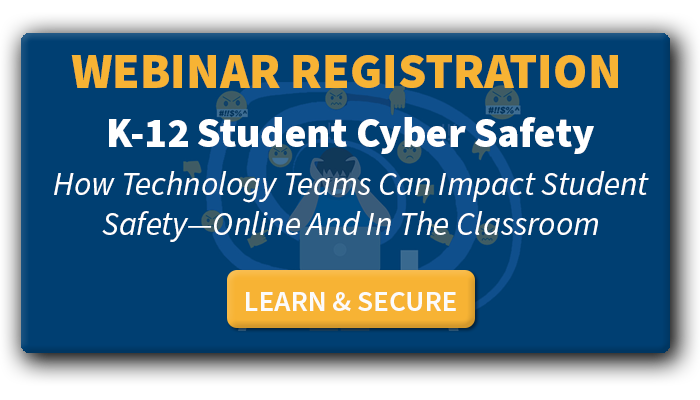IT teams can make a difference in student suicide prevention using their unique insights and expertise
If you’re on a school district IT team, no one expects you to be a trained psychologist, and you can’t be expected to be on the front lines of student suicide prevention. But, now that so much of school interactions are happening online, you are in a unique position to be able to shine a light into an area of student communications and behavior that is difficult for others to see. Your role in cyber safety in schools can make a big difference to a student in crisis.
The Unique Role of IT in Cyber Safety
There are three areas of K-12 cyber safety where today’s district IT teams bring unique expertise and visibility.
1. Overall Understanding of Technology, Implementation, and Integration
Cyber safety technologies have come a long way in a very short amount of time. Several software offerings are available to school districts to assist in these areas. Among some of the most popular are Gaggle, GoGuardian, and Securly.
In a typical school district, few people outside of IT understand how these technologies work and how to integrate them into a district’s system. Any investment in student safety technology needs the unique expertise of the IT team to ensure implementation is successful.
Different vendors provide different levels of behavior monitoring, control, and data privacy. And different vendors often put a different amount of emphasis on each of those three areas. In most cases, the IT team will be best equipped to understand the data privacy and security implications of different options and can provide recommendations from that perspective.
2. Visibility into Students’ Online Communications and Behavior
When a student decides to take their own life, that decision doesn’t happen in a vacuum. In most cases, student communications and behavior can signal that they, or someone they know, is in crisis before it’s too late.
Now that students are spending so much time online, both during school and on their own time, their communications and behavior are less visible to the adults in their lives. A district’s IT team is in a unique position to open up visibility into the students’ online world with monitoring technology that can detect troublesome signals.
One example of where IT teams often show leadership in detecting these types of behaviors to, hopefully, limit future tragedy is cyberbullying. Statistics show that students who are being bullied are at a higher risk of attempting suicide. And, in today’s online environment, a large amount of bullying is cyberbullying. Here are some important stats provided by the Megan Meier Foundation:
- Approximately 34% of students report they have experienced cyberbullying
- Students who have experienced cyberbullying are at greater risk of self-harm and suicidal actions
- Approximately 6% of students have anonymously posted online sharing harmful thoughts or feeling about themselves
- Students who experience cyberbullying are almost two times more likely to try to kill themselves
- About 1 in 20 students experience suicide each year
Self-harming is another student behavior that may signal future suicidal tendencies. While self-harm and suicide are very different actions, research indicates that self-harm behavior leads to suicidal tendencies at a greater rate than those who do not self-harm.
Students are using school technology to write about and/or share images of this kind of behavior. In many cases, it’s a cry for help that IT teams can help school counselors hear using self-harm monitoring technology. Monitoring for self-harming signals in district technology might include scanning for keyword strings in contextual information, detecting possible injurious behavior in images, and more. Most of today’s student self-harm detection will use a combination of keyword and regex scanning, image scanning, and artificial intelligence. Some vendors also provide teams who will investigate what the technology triggers before sending the alerts to school resources.
3. Fast and Objective Response
Your IT team should have little direct contact with students when you identify behavior that may indicate suicidal thoughts or behavior. Your role in student suicide prevention is to provide objective information based on the data the technology finds. And, you need to be able to pass that information on to those who are trained to respond quickly.
The goal for IT admins is to be as fast and objective as possible. You shouldn’t try to make a judgment call on what the technology finds. Quickly passing that information along to the right contacts in your district can, and has, meant the difference between life and death. Some student safety vendors also provide incident review by trained employees as an additional service.
K-12 IT teams are often the unsung heroes of our education system. Since most teams are deeply understaffed and underfunded, it can seem like involving them in student suicide prevention is unnecessary or over burdensome.
But, districts would be remiss in discounting the unique capabilities and expertise the IT team can provide. Many of the professionals in district IT departments that we work with never thought about how beneficial their involvement could be until they experienced it firsthand. Now, they see it as one of the most important and impactful parts of their job.

![[FREE WEBINAR] Student Cyber Safety in Schools. REGISTER HERE >>](https://no-cache.hubspot.com/cta/default/6834707/5cd0a157-352c-458b-9676-0ad9bb75645a.png)
